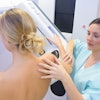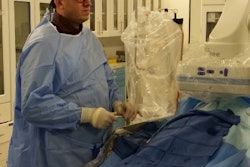
Quantitative measurement of prostate MRI exams can yield better lesion characterization performance than just qualitative assessment by radiologists, German researchers have found. But can machine learning do even better? At least for now, the answer is no, according to a study published online on 31 July in Radiology.
 Dr. David Bonekamp. Image courtesy of the German Radiological Society.
Dr. David Bonekamp. Image courtesy of the German Radiological Society.In a research project that including more than 300 patients biopsied for prostate cancer, researchers led by Dr. David Bonekamp from the German Cancer Consortium in Heidelberg, Germany, found that the mean apparent diffusion coefficient (ADC value) on multiparametric prostate MRI yielded higher sensitivity and specificity than Prostate Imaging Reporting and Data System (PI-RADS) assessment by radiologists. While a radiomics machine-learning approach also produced good results, it did not yield a statistically significant improvement in accuracy over a threshold mean ADC value.
"Quantitative ADC alone successfully characterized a lesion as clinically significant prostate cancer in both the peripheral and transition zone; no further benefit was demonstrated with complex radiomics and machine learning methods," the authors wrote.
Hypothesizing that radiomics could improve the characterization of MRI-detected prostate lesions, the researchers sought to compare the performance of radiomics and mean ADC using a sensitivity threshold equivalent to clinical reporting. They developed models based on both the mean ADC value and a radiomics technique based on machine learning. Versions were created to analyze the prostate as a whole and also by specific prostate zones.
Performed at a single institution, the study included 316 men who had an indication for MRI-transrectal ultrasound fusion biopsy between May 2015 and September 2016. All patients received an MRI exam acquired prior to biopsy using standard guidelines on a Magnetom Prisma 3-tesla MRI system (Siemens Healthineers). Lesions identified prospectively during radiologist interpretation were later segmented manually for both mean ADC and radiomics analysis.
Of the 316 patients, 183 were used as a training cohort, and 133 were set aside as a testing cohort. Clinically significant prostate cancer (Gleason grade group ≥ 2) at histopathologic examination was the reference standard.
| Lesion characterization performance testing cases | |||
| Radiologist PI-RADS assessment | Mean ADC value | Radiomics with machine learning | |
| Sensitivity | 53/60 (88%) | 54/60 (90%) | 58/60 (97%) |
| Specificity | 79/159 (50%) | 99/159 (62%) | 93/159 (58%) |
The difference in classification performance between the mean ADC value and the radiologist interpretation was statistically significant (p = 0.48). From receiver operating characteristic (ROC) analysis, the researchers did not find a significantly different area under the curve, however, between the mean ADC value and radiomics machine-learning approaches. They noted, though, that both techniques reduced the number of radiologist classification errors more on a per-lesion basis than on a per-patient basis.
"This is consistent with a recent report that prospective PI-RADS assessment has excellent performance on a per-patient basis but weaknesses in the identification and characterization of individual lesions," they wrote.
Although machine learning and radiomics did not beat the predictive performance of monoparametric ADC assessment in their study, the development of next-generation machine-learning techniques in multicentric setups may produce a different result in the future, according to the researchers.



















